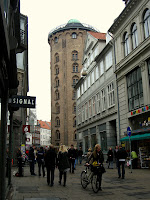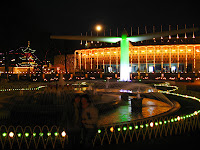 of 10-11- and all of them suffer ADHD - Attention Deficit Hyperactivity Disorder. They have two teachers: Deby and Lars.
of 10-11- and all of them suffer ADHD - Attention Deficit Hyperactivity Disorder. They have two teachers: Deby and Lars.I have already written about system of this school and the daily routine of children in this class, so I'm going write only those things, which were new for me or I got more information about what I have already known before.
Events of the 3 weeks:
The day usually starts with the morning sing for all of the pupils in the great hall. Then continued by 'runden' (round) in the classroom, when children are riported about what happened with them since the day before. For these children the frames, rutines are very important, because they feel themselves secured in this way. After this the day countinues by F.U.T., which is the combination of running and repeat the spelling of certain words. They have to run round and round in the school yard and Deby asks for a word of pupil by pupil in every round. It takes about 10 minutes and they usually take 4-5 rounds in the yard. For these children is really difficult to be calm and focusing only one thing, so it's a very good way to make them work.
The next lesson is usually Danish, where they can pick up any book from the library and they have to read in their own (with Lars) in the silence room and after that they have to read one by on to Deby. They also have to work in workbooks, which are different depending the each level - 1- 4 grades - what they have.
They have quite long - 30 minutes - break twice a day, because they need more physical activity than the other children. They can become agressive easily and sometimes there are some conflicts between them. That is the reason - when the break finishes - they usually have to wait outside - at the entrance of the building - an then the teachers can question them what happened. They usually tell the children there, what will be the next task. There are some "do it again-rules", for instance: if they still shout after entering the building, they have to go out and come back again.
They started a sort of "project" weeks ago, so they continued this during the weeks, when we were there. They were divided in groups and each groups had to choose a country and find out as more as they could about it. They had to use computers to this task and find these general information about the choosen county: language, capital, president, valuta, history, military...etc. It was really hard for them to work in pairs and to focus only the information above, so they were really slow and they haven't finished it yet.
Their favourite subject is gymnastics. One of the week (it's only once a week) they played basketball. Normally they have difficulties to understand the rules of the game and playing against each other in fair way, so they needed some warming-up excersises:
- Playing basketball alone - They bounced the ball in their owns.
- Working in groups: throwing the ball to each other and then changing pairs.
- Working in two groups: they were diveded to 2 groups - 3 and 3 - and they had to play underneath each backboards. They had to stand in a triangle and pass the ball to each other and the person from the middle had to throw the ball into the basket. Then they changed the position (The game was going around.)
- After all of these excersises above they had a "real"game together.
Finally they finished by lying on a rug and and listening classical music. The latter is very hard for them to staying in one place without moving and with shouted eyes.
In the other week they practised for a championship, which is for special schools. We went out with them to the football ground. They had to run, jump into the sand and play (a sort of) baseball. They were spread on the ground and they had to pass tennis balls to Lars, who tried to hit them back.
In every week they go to the swimming pool, which is close to the school. Lars teaches them to swim and Deby stays outside to gives instructions from them. It usually takes half an hour and at the and there are five minutes to play, what they want. This activity is very good for them to make them tired.
Before Easter they prepared some handcrafts: cards, stickers to the window wiht a special paint,...etc. They needed lots of help from both of the teachers and us as well, because it is difficult for them to concentrate to the task, being precise.
One of the Art lesson they went outside to draw the buildings of the school from different angles. They had to spread in the school yard and draw, what instruction was given. They were on their owns, but Debby and Lars kept go around to help them and we also encouraged them. One of them it was told to start a new one, because he finished that too early. He was nearly cried...According to this most of them have a good sense to draw. It was really suprising for us, because to draw something you have to be patient and have a "good sight" to see the tiny details.
One day 5 out of 8 didn't do their homework. If this happens teachers have to report the parents in the message books.
In every year teachers testing the developement of children in Danish and Math. We just saw the testbooks of Danish. There were 4 different levels - 1-4 grades -, because the knowledge of these pupils in different levels as well.
 Therefore there are 4 different kinds of testbooks:
Therefore there are 4 different kinds of testbooks:- In the first grade one: there are one word and four different pictures in one row. Pupils have to find the appropriate picture, which matches with the word.
- Second grade is nearly the same, but more difficult words.
- Third grade is the same structure, but with short sentences instead of words.
- Fourth grade is the same like above, but with more difficult sentences.
Whenever a child enroll to the institute, teachers have to do a statement about each of the children and they have to update it in every half year (December, June). This statement contains:
1. Some personal information about children: name, personal number, which social service the child belongs to, when he/she started the school, name of the parents, who made the statement? when?...etc.
2. Absolutions: all of the national tests, gradings, exams
(Whenever a child absolve of a subject, gradings...etc., it has to be reported to the principal the social authority and they send the document forward to the Department of Education. Then they check the reasons and they approve or disapprove it. So it's a long process...)
3. Teaching: how the child copes with it from the beginning
4. Personal characteristics: generally: does the child has a normal height, weight, comparing with the age of him/her; what the pupil able to do?: e.g. express feelings...etc. (present); goals for the future with the student
5. Social functions (in the same dimensions, like in number 4.)
6. Physics (in the same dimensions, like in number 4.)
7. Communication, ability to communicate (in the same dimensions, like in number 4.)
8. Danish (in the same dimensions, like in number 4.) + used materials
9. Math (in the same dimensions, like in number 4.) + used materials
10. Gym (in the same dimensions, like in number 4.) + used materials
11. Functions in practical a musical subjects (in the same dimensions, like in number 4.) + used materials
12. Extra subjects (in the same dimensions, like in number 4.) + used materials
13. Other important information: e.g.: general knowledge is very limited, lack of realistic thinking about world, telling lies...etc.
14. Conclusion: summary of the whole statement
In the great hall the "Ergo therapy" takes place in every Tuesday. It's for an other class - 1-2. grade - with the same disorder. This therapy help them to cordinate their movings (legs, arms, eyes...etc.). First there are some warming-up excercises (during that the music is on), then they get drawing boards and papers. First the therapist draws to the blackboard, and then they have to repeat the same movements and put everything to the paper and it continues deatails by details until the drawing being completed.
On the third week we spent 2 days in one of the class of the oldest pupils with ADHD as well. There are 6 boys in the class with two teachers. They also come from a hard social and family bacground. It was a nice experince to be there. We could manage to communicate them in English. (It was nearly impossible in the lower class, because they can understand only Danish.)
 They have nearly the same routine then the younger ones, but they don't need to participate in morning sing (they're too old for this); they have 'Dugens' instead. Dugens is about the teacher ask funny and strange questions from a book, and pupils have to find out what is the explanation of them.
They have nearly the same routine then the younger ones, but they don't need to participate in morning sing (they're too old for this); they have 'Dugens' instead. Dugens is about the teacher ask funny and strange questions from a book, and pupils have to find out what is the explanation of them.We had English with them: we played 'Simon says'-game, which is about: one of the pupils has to sit front of the others - he is 'Simon', who gives instructions for the others. But the only case when it's allowed to change the position, when the person, who gives the instruction add these words to it: 'Simon says turn around'. So if the instruction is "turn around", it is not allowed to move. Pupils easily get confused, because after a while everything comes automaticly and they change the position without the words - 'Simon says...' as well. If it happens that person(s) fall(s) out from the game.
It is a good game to make them concentrate and practise English as well (the instructions are in English).
Even they are 14 years old, some of them have only 1-2. grade level in Danish. So they use different kind of books, workbooks as well. This is the reason they are separated in to groups: the weakers with one teacher, and the better ones with an other teacher, in different rooms.
One of the pupils have to go back a lower class from next semester, because he backwards from his classmates in all of the subjects and mentally as well.
Before the breakfast there is a 15 minutes "computer-break", when they can play with selected games. After 10 minutes the teacher needs to count back in every to minutes, otherwise if she would interrupted them without gradation, they would became very agressive.
When we said goodbye they huged us and they seemed to be disappointed to leaving them.
It was the same with Deby& Lars class. When Debby said them we won't come back anymore, all of them said: 'no'. It was hard for us as well. It's always the same with practises: by the time you get use to everything and children start to trust in you, you have to leave..
























































